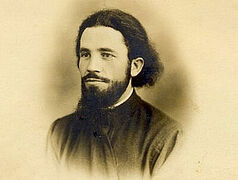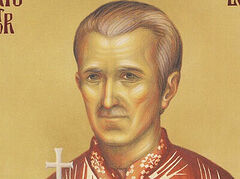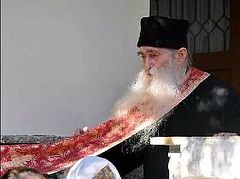Childhood
On January 27, 1919, Ioan, the second son of the Macedonian Nicolae Ianolide, was born in the Romanian village of Dobrotești, Teleorman county. His mother, Aspasia, like any woman, rejoiced at her successful delivery. The poor woman couldn’t have imagined that these birth pains were only the beginning of her suffering for Ioan, whose lot on earth would be martyrdom. But now she was overwhelmed with joy.
 Nicolae and Aspasia Ianolide, Ioan’s parents
Nicolae and Aspasia Ianolide, Ioan’s parents
Like all children growing up in the countryside, Ioan was spiritually formed in an atmosphere of piety: church services, Christmas carols, funerals, Vigils and Trinity Sundays—everything created the conviction in his soul that Christ was present everywhere. “He soars in the air with all His angels, helping us to be sanctified and saved.”1 His grandmother and mother, very pious women, endowed with spiritual wisdom from God, played the main role in his development. Under these conditions, Ioan developed a natural, close and inseparable link with Christ. Life without Him seemed unthinkable, because God filled his soul.
 Ioan Ianolide as a lycee student, 1938
Ioan Ianolide as a lycee student, 1938
His childhood passed smoothly and calmly. But the period of the changeover of dictators began in Romania, which brought endless conflicts and social upheavals, and he couldn’t remain indifferent to the challenges of his time. Thus, in 1937, like most of the youth of the interwar period who cherished high moral ideals in their souls, he joined the Brotherhood of the Cross—a nationalist organization, which aimed at promoting religious and moral education amongst the younger generation.2 An inexperienced dreamer, he hoped to see Romania freed from the vices of bourgeois politicking and Bolshevik atheism. He joined that struggle, which drastically changed his whole life.
 Lycee student Ioan Ianolide and classmates
Lycee student Ioan Ianolide and classmates
After graduating from the lycee (since his parents’ financial situation was good) he went to Bucharest to study law.
Arrest and conviction
He was a first year student when Romania entered World War II. Against the backdrop of these serious historic events the country was going through, on October 19, 1941, a meeting was scheduled for a large group of young people with Ioan at the head for educational work. It took place in a forest on the outskirts of Bucharest, but turned out to be a fake meeting orchestrated by the authorities. Eugen Cristescu, Director General of Special Intelligence Service, needed an attempt on the life of Marshal Antonescu in order to provoke a conflict with the Legionnaire Movement. It was to this end that he arranged that clandestine meeting of the Brotherhood of the Cross in the Băneasa Forest. The Secret Police placed their agents in the forest and its vicinity in advance, and then arrested every youth who caught their eye. Ioan was among them.
 Department of Law, University of Bucharest
Department of Law, University of Bucharest
All the arrested students were taken to the main police station. Years later, a participant in that dramatic event recalled that Ioan “was brought in with his hands tied. The agents beat him and treated him roughly. But despite all their brutality, he remained dignified, with his head held high. He was a model of courage and bravery for others.”
The students’ interrogations began with the use of pressure, threats, and promises to release them if they confessed their intention to take part in the illegal meeting and shift the blame on the organizers, primarily on Ioan. Ioan was brutally beaten during interrogations and had to write with his left hand, but this inhuman treatment brought him even closer to God; and while waiting for the trial he prayed fervently, asking nothing from his friends.
At the court’s decision, eight members of the Brotherhood of the Cross received different terms, and Ioan, according to verdict No. 2208 of the November 21, 1941 court-martial, was sentenced to the maximum term: twenty-five years of forced labor “for the involvement in an organization prohibited by law.” But, despite all the blatant injustice, Ioan remained calm. The same witness recalled that when he was given the final word to say, “Ioan Ianolide was the only one to declare that he was happy to be condemned for the faith that lived in his heart and for the struggle he was waging in defense of the Romanian people. When his sentence was announced, he stood at attention, turning his gaze to heaven, with his face shining with joy. The representatives of the authorities were stunned. They had never seen anything like that.” Thus the twenty-one-year-old student Ioan ended up in prison.
Aiud, the first years of mental anguish
 Ioan Ianolide in the first years of imprisonment
Ioan Ianolide in the first years of imprisonment
On a nasty, frosty day in January 1942, Ioan, chained hand and foot, was taken with other young men to Aiud Prison to suffer for Christ and the people.
Having arrived, they found a harsh prison regime with disgusting food and unbearable cold. To top it off, the head of the prison would terrorize them unceasingly, turning their lives into a nightmare.
 Monument to the victims of Communist prisons. In the background: buildings of Aiud Prison; in the foreground: the Ravine of Slaves; the door at the base of the monument leads to the Skete of the Ascension of the Lord
Monument to the victims of Communist prisons. In the background: buildings of Aiud Prison; in the foreground: the Ravine of Slaves; the door at the base of the monument leads to the Skete of the Ascension of the Lord
From the very beginning, Ioan viewed prison as his martyrdom:
“Full of dreams and ideals, knights of a vanished era, fools for the sake of the Cross, bearers of honor and dignity, we actually were fighting the whole world. We didn’t know the reality and lacked any sense of self-preservation; we were naive and fell into the wolf’s mouth—but what else could we do? We couldn’t stain our souls. Getting involved in this fight, we deliberately went to martyrdom.”
In those terrible conditions he eagerly engaged in self-education, in particular law, philosophy, politics, sociology and education. But his main concern was his soul—he prayed for hours, performing nightly prayers, vigils and reading the Holy Scriptures every day.
Despite all his strenuous efforts, Ioan had not yet reached the spiritual life, because he had not overcome his pride—and without this it is impossible to acquire compunction. Moreover, he was aware of certain common human sins, but didn’t want to admit them because of self-love mixed with shame. And he had no father-confessor.
Thus, God hastened to send Ioan an occasion for perfection and humility. One day, the prison torturer demanded that he publicly confess that he was a bandit and he (the torturer) was a respectable person. Broken by the pain, Ioan surrendered; and that moment, though humiliating, became a turning point in his life as it made him rethink his whole life: “Then I fell on my face and for the first time in my life said from the bottom of my heart: ‘I am the worst sinner!’”
Now, after such self-humiliation, his pride was finally crushed, and he became unbearable to himself. In this desperate state he learned from an imprisoned priest about hesychasm and the prayer of the heart, and so he labored at it for several months. Having been renewed in spirit, he decided to devote his whole life to Christ.
Years later Ioan would recollect:
“I desperately needed a father-confessor to whom I could open my innermost feelings and ask him to become my mentor. I knew that a priest is a bearer of grace, and I wanted him to give me some of the Divine power and light I so longed for.”
Soon by Divine Providence one of the prisoners, Fr. Arsenie (Papacioc), became his father-confessor. And Ioan always considered Fr. Arsenie the “builder” of his soul.
 The imprisoned Monk Arsenie (Papacioc), 1958
The imprisoned Monk Arsenie (Papacioc), 1958
The beginning of putting his inner life in order was not easy, but Ioan was zealous, and by obeying Fr. Arsenie he greatly succeeded on the path of perfection. Every day they talked on spiritual subjects, and he read such books as the Patericon, The Imitation of Christ, and the Philokalia. And the old man began to die in him day by day, allowing Christ to be born in his heart:
“The separation from the old ideas, friends, and activities was painful, but the discovery of new perspectives overwhelmed me with such joy that the path became irreversible.”
During that period, the abundant grace of the Holy Spirit descended upon him, so he no longer felt hunger or other prison sufferings, attained inner peace, and even his sleep was full of beautiful dreams.
After a thorough “examination” by his father-confessor, he confessed his sins and received penance, after which, inspired by the joy of Divine forgiveness, he did something more, which determined his future. He went to the cell where Valeriu Gafencu șand Marin Naidim lived, and resolutely, humbly and frankly confessed to them all his sins from the list he had prepared for confession: “I want you to know me as I am, naked in all my nakedness, and help me if you can!”
 The prisoners Valeriu Gafencu șand Marin Naidim
The prisoners Valeriu Gafencu șand Marin Naidim
These two friends were so astonished by Ioan’s frankness that they confessed their sins to him in return. So they decided to live together in the same cell (fortunately, in those days it was allowed) and an atmosphere of intense spiritual life reigned there. They prayed together day and night, read and interpreted sacred texts, and completely trusted each other.
During that period, Ioan acquired the skill of wood carving and began making crosses and icons—an activity he didn’t part with for the rest of his life.
A slave at Galda de Jos Prison
Since Romania’s participation in World War II led to the depletion of food supplies, in the winter of 1945 the prisons received an order from the ministry to provide themselves with supplies, using prisoners’ labor for this as the State could no longer grant subsidies. So Ioan was transferred to the labor camp of Galda de Jos together with Valeriu Gafencu, Virgil Maxim, Marin Naidim, Costică Dumitru and other ascetics to work in the fields of a local landowner.
Although life in the labor camp was semi-free, they endured terrible hardships, since the owner of the estate for whom they worked didn’t allow them to eat the fruits of the earth. But they were allowed to communicate with their relatives, attend the nearest church and leave the estate for a short while.
 Ioan Ianolide with Valeriu Gafencu and his mother at the Galda labor camp, 1946
Ioan Ianolide with Valeriu Gafencu and his mother at the Galda labor camp, 1946
Under these conditions, Ioan met Valeriu’s younger sister and became attached to her, and they were betrothed in a village church so that after his release they could get married. However, before that they had to endure much more suffering.
 Ioan Ianolide in the Galda labor camp with Valentina Gafencu
Ioan Ianolide in the Galda labor camp with Valentina Gafencu
Work in the fields was exhausting; they almost always had to work hungry, but they flavored work with prayer, brotherly exhortations and love, as they used to do in Aiud Prison. However, they enjoyed such a lifestyle only for a couple of years, since the Communists, who had gained unlimited power in the country, decided to re-educate the “enemies of the people” and for this purpose prepared something absolutely diabolical for the students.
To be continued…




